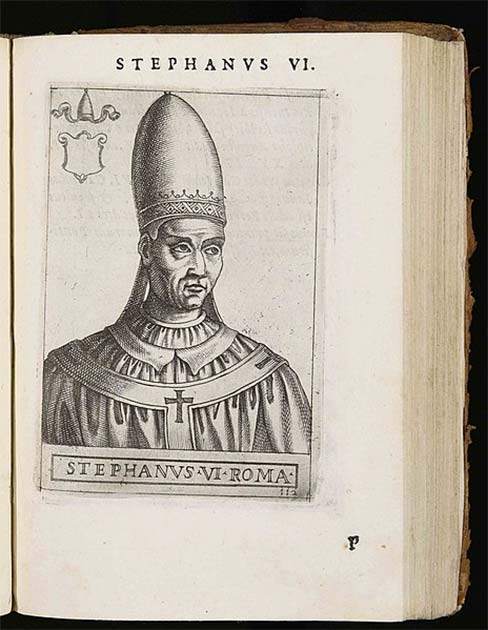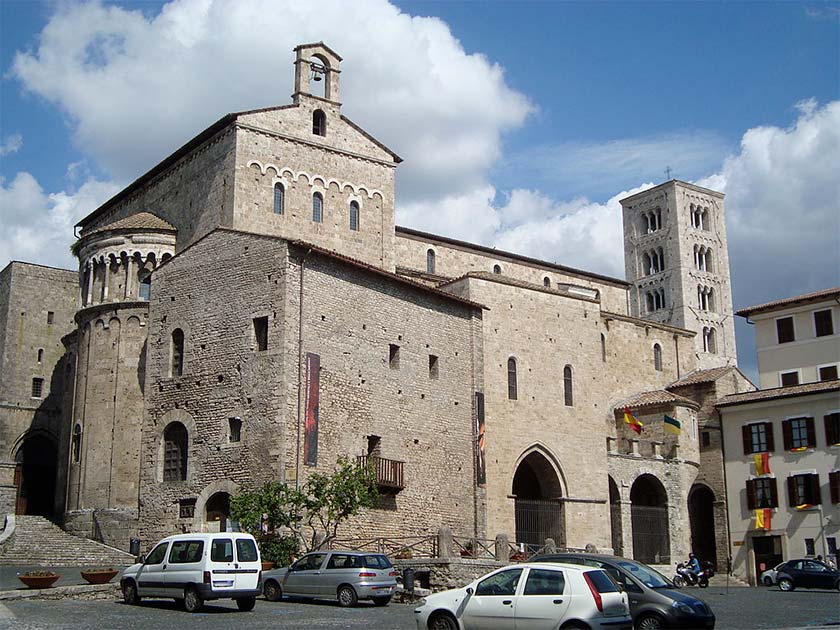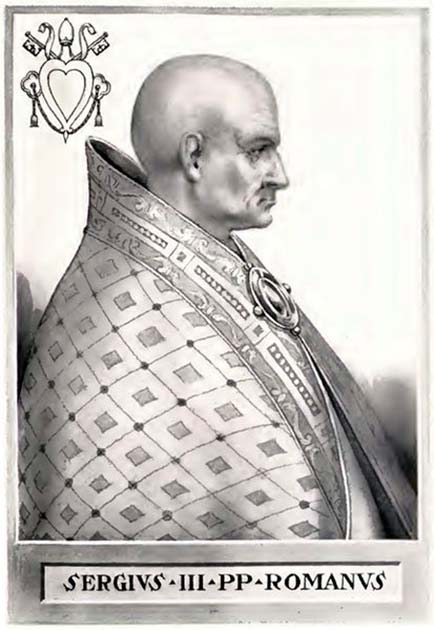The pope is seen as a model of purity. However, quite a few popes from history were less than pious and are remembered for things like sex scandals, violent outbursts, gambling, and more.
One of the naughtiest of these naughty popes was Pope John XII, who was only 18 years old when he was elected and was not ready to give up the fun lifestyle he had. He turned his home into a brothel, was accused of castrating a cardinal, and would gamble with the money from the church.
He was also accused by Otto of Saxony of “homicide, perjury, sacrilege, incest with your relatives, including two of your sisters, and with having, like a pagan, invoked Jupiter, Venus, and other demons.” John’s rule as pope finally ended at the hands of a jealous husband, who came home to find his wife in bed with the pope and beat John to death.
Or there was Pope Benedict IX, who was pope three different times, and everyone hated him. Benedict IX was “placed” into the role of the pope when he was around 12 years old, in 1032.
When the boy learned political opponents were trying to kill him, Benedict absconded to Rome for a while. For some unknown reason, Benedict IX decided he wanted to be pope again, so he returned to St. Peter’s Basilica in 1045. Benedict deposed his replacement and named himself the pope again.
Round two of being the pope didn’t last too long. He was reportedly offered a large sum of money to step down. He essentially sold the papacy to the next guy. Like a boomerang, Benedict IX returned and was pope for the third time after capturing the throne after Pope Clement II died in 1047.
Again, he was not the pope for very long. Henry III of the Holy Roman Empire ran Benedict out of town, and the triple pope was never seen again. These are just two of the many “bad popes” throughout history. There is one pope who stands above the rest Pope Formosus, the man, well, the corpse of a man at the center of the infamous Cadaver Synod.
Pope Formosus
Pope Formosus was born in 816, possibly in Rome. He became the cardinal bishop of Porto in 864, and two years later, Pope Nicholas I appointed Formosus as a legate to Bulgaria in 866. A legate is a personal representative of the pope to foreign nations.
Pope Formosus participated in diplomatic missions to France in 869 and 872. Formosus was well-liked and converted many people in Bulgaria to Catholicism; in fact, Boris I of Bulgaria asked the pope to appoint Formosus as the archbishop of Bulgaria.

Pope Nicholas I refused to name Formosus as Bulgaria’s archbishop because a rule strictly forbade a bishop from “administering more than one see.” Essentially, this rule was established so bishops would not essentially build their own powerful fiefdoms.
When Louis II of Italy died in 875, things became complicated for Pope Formosus. The Italian nobles elected Louis II’s uncle, Charles the Bald, as the new emperor, and Formosus invited Charles to Rome at Pope John VIII’s request.
Charles was crowned and received the imperial insignia on December 29th in Rome. Everything sounds great; however, Louis had another uncle, Louis the German. He died, but his widow opposed the coronation of Charles, and many people were on Louis the German’s side, and they were not happy.
- Pope Joan: Did The Church Elect a Female Pope?
- The Avignon Captivity: Why did the Pope move to France?
Many left Rome fearing retribution from the new emperor, including Formosus, who fled to Tours, France. In April of that same year, Pope John VIII called a synod, an assembly of the clergy in a diocese or some other division of a particular church, which ordered all papal officials, including Formosus, to return and meet in Rome.
Formosus refused to return to Rome and, as punishment, was excommunicated because he had “deserted his diocese without papal permission, and aspired to the position of archbishop of Bulgaria.” Aspiring or alleged aspirations to achieve a higher rank in the Church were forbidden. Also, Formosus was charged with despoiling the cloisters in Rome and “was in opposition of the emperor.”
The excommunication and condemnation of Formosus and other clergy members were made official in July of 876. Ironically, Formosus was already at this point a candidate for the papacy, having been touted as such since as early as 872.
His excommunication proved problematic, but the sentence was withdrawn in 878 when he promised never to return to Rome or serve as a priest again. Here is where things get even more complicated: Pope John VIII’s successor Marinus I restored Formosus to his high-ranking role in the Dioceses of Portus.
During this time in history, there was a lot of instability in the Catholic Church, and there was an almost revolving door of popes in and out of Rome. Marinus I was pope for one year, then was succeeded by Stephen V, who was pope for six years. Then in 891, Formosus was elected to be the new pope. Somehow an excommunicated priest managed to be reinstated and then elected to become Pope Formosus.
The Cadaver Synod
Almost immediately after becoming the pope, Formosus was called to Constantinople to address a political usurpation. Photius I had been ejected from his role, and the son of Emperor Basil I, Stephen I, took his place. Pope Formosus refused to reinstate individuals ordained under Photius whose roles had been nullified by Stephen V, Phoitus’ predecessor.
Pope Formosus also had issues with the current emperor, Guy III of Spoleto; the pope did not trust him and began to try to find support against the emperor. Guy could tell Pope Formosus was not a fan and forced the pope to crown his son Lambert “the co-emperor” in April 892.
Pope Formosus went behind the father-son emperor duo’s backs and encouraged Arnulf of Carinthia to attack Rome to “liberate Italy from Guy’s control.” The first attempt at this was unsuccessful, and when Guy died in 894, Lambert, who was still young, was left in the care of his mother.
Lambert’s mother was a significant opponent of the Carolingians, leading Arnulf to invade Italy again in 895, where he successfully seized Rome. The day after Arnulf captured Rome, Pope Formosus crowned him the emperor. Pope Formosus died on April 5, 896, and was succeeded by Pope Boniface VI, who was the pope for only 15 days.

Boniface VI’s successor was Pope Stephen VI, and he was close to Lambert and his mother, Agiltrude, and the new pope decided to be incredibly petty. In 897, what became known as the Cadaver Synod took place.
This event saw Pope Stephen VI disinter the corpse of Pope Formosus, who had been dead for around seven months. Stephen VI forced the body to stand trial for the crimes Pope John III had excommunicated him for, more specifically, for seeking the papacy and ruling over more than one place as a bishop.
The decaying corpse of Pope Formosus was dressed up in papal vestments and was sat on the throne at San Giovanni Laterano to face the charges made against him. Pope Stephen VI assigned a young deacon to act as Formosus’s defense attorney and speak for him. Pope Formosus, whose name means “good looking,” was anything but: he was decaying and had to be held upright in the throne while Pope Stephen VI screamed at the corpse in front of an audience.
- Papal Resignation and Papal Murder: Popes Celestine V and Boniface VIII
- When Women Ruled the Papacy: Marozia and the Pornocracy
As one would expect, Formosus’s appointed representative didn’t have much to say because, well, he was representing a literal corpse. During the trial, an earthquake was felt in the basilica and even caused damage to the building, horrifying the already repulsed trial attendants.
Still, come hell or high water, Pope Stephen VI was going to see the trial through to the end. A chronicler, Liutprand of Cremona, recorded that Stephen demanded Formosus to answer the question, “When you were bishop of Porto, why did you usurp the universal Roman See in such a spirit of ambition?”, to which Pope Formosus made no reply.
The Verdict
The verdict of the grossest trial in history was that Pope Formosus was guilty and unworthy of being named Pope. The sentence for the corpse’s crimes was to be removed from all official accounts, written out of papal history records.

That wasn’t all; Formosus’s measures, acts, and orders he made while Pope were immediately annulled and made invalid. You are wrong if you thought that was all the punishment the dead Pope Formosus was to receive. His papal vestments were literally torn from his body, the three fingers on his right hand that he would use in blessings were chipped off, and the rotting corpse was placed in a graveyard for foreigners.
However, that was too light of a sentence for Stephen VI. He had Pope Formosus dug up once again just to attach weights to the corpse and tossed it into the Tiber River like a sack of disgusting potatoes. Allegedly a monk later went out and retrieved Pope Formosus’s corpse from the river.
While Pope Stephen was quite satisfied with the events and results of the Cadaver Synod, the Roman public began to turn against him. A public uprising occurred, which deposed Pope Stephen VI, and he was held in jail as a prisoner.
Pope Stephen VI was later found strangled to death in his cell in either July or August of 897. While putting a corpse on trial is insane, there might have been a reason Stephen VI called the Cadaver Synod. It is believed that the trial was possibly a cover for Stephen, who was guilty of the same crimes of which he accused dead Pope Formosus!
Pope Formosus had made Stephen a bishop, and when he became pope, he was also given the title of “bishop of Rome,” which comes with the job. Being the bishop of two places was illegal and was what Pope Formosus was previously excommunicated for and was on trial for during the Cadaver Synod.
Stephen technically was the bishop of two places, and if Pope Formosus were found guilty of his crimes, his rulings, orders, and appointments would be nullified. The nullification would mean that technically and legally, Stephen would not have been a bishop when he was elected Pope.

There is the possibility that the Cadaver Synod was Stephen’s way to drum up political alliances with anyone who hated Pope Formosus, but that would have left Stephen open to being placed on trial as well. It is also worth considering that Pope Stephen VI was utterly insane.
In December 897, Pope Theodore II called a synod to annul the Cadaver Synod and ordered that Formosus’s body be returned and buried in Saint Peter’s Basilica in papal vestments. Then the following year, Pope John IX convened a synod in Rome and a second synod in Ravenna to nullify the Cadaver Synod further.
John IX ordered that putting a corpse on trial be prohibited, and he excommunicated seven cardinals involved with the Cadaver Synod. Then Pope Sergius III, a bishop who took part in the Cadaver Synod as one of the judges, overturned the two prior nullifications of the Cadaver Synod and reaffirmed Formosus’s conviction officially. Formosus is still buried in Saint Peter’s Basilica and is included on a list of popes buried there.
Top Image: Pope Stephen Vi accused his predecessor Pope Formosus in what became known as the Cadaver Synod. Source: Jean-Paul Laurens / Public Domain.